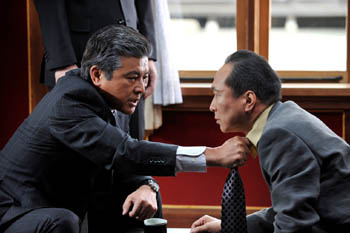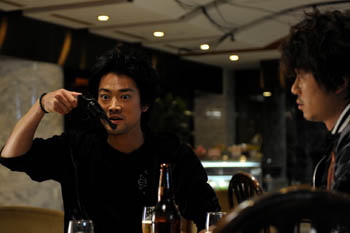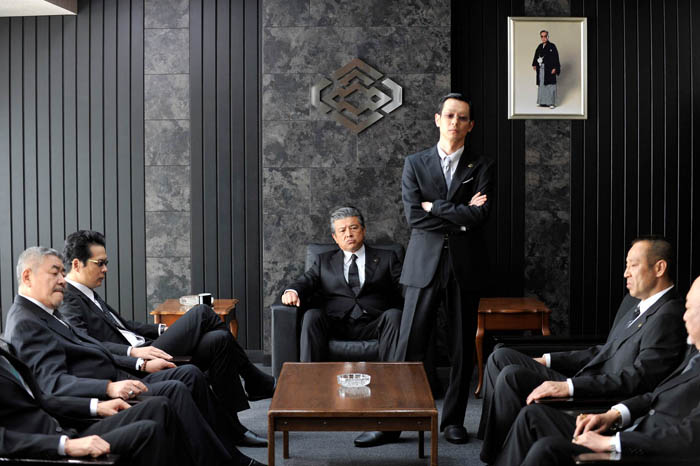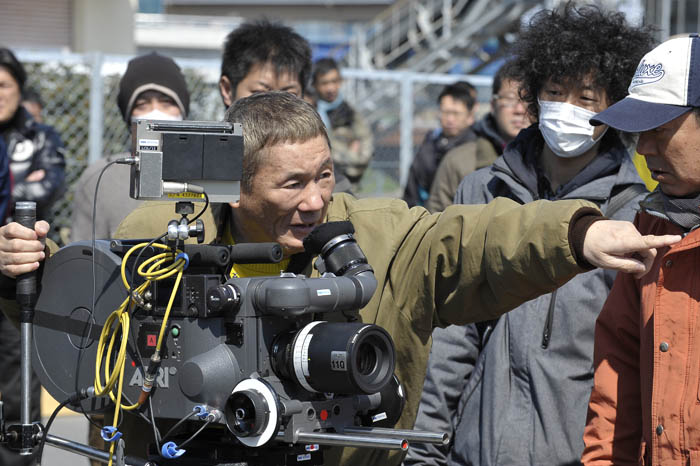 Otomo (Takeshi Kitano) is back from the dead, out of prison, and deep in trouble once again in OUTRAGE BEYOND, the sequel to Kitano`s gangster film OUTRAGE. Photo courtesy of Warner Bros. Pictures Japan. ? 2012
Otomo (Takeshi Kitano) is back from the dead, out of prison, and deep in trouble once again in OUTRAGE BEYOND, the sequel to Kitano`s gangster film OUTRAGE. Photo courtesy of Warner Bros. Pictures Japan. ? 2012 Source: Warner Bros. Pictures Japan, FilmPressPlus Official Site: warnerbros.co.jp/outrage2 (Japan) Translations: Elliot Gay Special Thanks to Richard Lormand
SPOILER WARNING: This article contains plot details and images from an upcoming movie.
A manipulative police crackdown on organized crime ignites a tricky power struggle involving the two biggest yakuza families in OUTRAGE BEYOND (?????? ????, Autoreiji Biyondo), the new film by "Beat" Takeshi Kitano (OUTRAGE, BROTHER, HANA-BI) opening in Japan on October 6, 2012.
SYNOPSIS The huge Sanno crime family has grown into a huge organization, expanding its power into politics and legitimate big business. The Sanno’s upper ranks are now dominated by young executives who promote black-marketeering rather than the traditional underground income sources. The old-guard members are penting up resentment as they see themselves being pushed to the sidelines. This vulnerable spot in the Sanno hierachy is exactly what anti-gang detective Kataoka has been looking for, as the police force prepares a full-scale crackdown. With secret plots and dirty tricks, the ambitious Kataoko will open up a whole new game of yakuza power struggle. Detective Kataoka intends to instigate conflict between the Sanno and the Hanabishi, their long-time neighboring ally, in the hopes that they ultimately destroy each other. To help weaken the Sanno, the underhanded cop also provokes their grumbling old-guard executives to consider usurping Chairman Kato from top position. And Kataoka’s trump card is the arranged release from prison of Otomo, the rumored-dead boss of a family once crushed by the Sanno. The news of Otomo’s release creates tension in the Sanno family. Especially nervous is underboss Ishihara, whose betrayal put Otomo in jail. Fear drives Ishihara to start up a frenzied manhunt to shoot Otomo on sight. But Otomo has no plans on seeking revenge nor does he even intend to be yakuza anymore. Crafty cop Kataoka, however, insists and pushes Otomo to help the police bring down the Sanno family. He forges an unlikely pact between Otomo and Kimura, a former underboss of another family now defunct due to Sanno reign. Kimura also happens to be the guy who stabbed Otomo in prison, making their eventual “sake pact” all the more delicate to maneuver. With the sense of approaching yakuza warfare, deception and betrayal smolder among the families as everyone watches out for the other’s next move. It’s impossible to guess who will come out on top in this fierce power game. It’s not over until it’s over.
A PACT SEALED OVER SAKE In OUTRAGE BEYOND, director Takeshi Kitano highlights those strong relationships that are unique to the yakuza world. The spiritual nature of the absolute bonds of “kyodai” (brothers) and “oyako” (father and son) go far beyond the actual relationships between blood brothers and real fathers and sons. These pseudo-familial relationship pacts are sealed during the ritual sharing of sake (“sakazuki”) between individual yakuza to define their hierarchical relationship inside an organization. Once one shares the sake, one cannot dissolve the pact easily, which sometimes can work against one’s interest. These pacts over sake are so solid that yakuza are even willing to die for a “brother,” “father” or “son.” In yakuza films, even some by Takeshi Kitano, these relationship pacts are often romanticized, but in OUTRAGE BEYOND, we witness the vanity of this tradition. There is nothing virtuous about these yakuza. OUTRAGE BEYOND, Takeshi Kitano’s first ever sequel film project, was launched in the hope of domestic release in fall 2011. The preproduction process of script writing and casting went off smoothly and Kitano and his team were holding costume fitting sessions at Nikkatsu Studio in Chofu, Tokyo, when they experienced the Great East Japan Earthquake on March 11th, 2011. The production came to a halt and was tentatively postponed shortly thereafter. All concerned parties including crew and cast members agreed to resume the project a year later. The shooting began in Kobe on April 2nd, 2012, one year after initially scheduled . Kitano and his team shot on location across the country in Aichi, Chiba, Kanagawa, and Ibaraki and wrapped on June 2nd. The film is scheduled to be released Fall 2012 in Japan on more than 200 screens, the biggest release ever for a Takeshi Kitano film. COMMENTS FROM TAKESHI KITANO “Risking your life for the family means less now. What matters is how much money you can make for them.”
 Sanno Family Underboss Ishihara (Ryo Kase) lashes out. Photo courtesy of Warner Bros. Pictures Japan. ? 2012
Sanno Family Underboss Ishihara (Ryo Kase) lashes out. Photo courtesy of Warner Bros. Pictures Japan. ? 2012 A NEW TWIST TO OUTRAGE OUTRAGE BEYOND was a way for me to give a new twist to the fairly straightforward story of OUTRAGE. We can even consider the first OUTRAGE as foreshadowing for OUTRAGE BEYOND. With this in mind, I made a conscious effort to turn things around and go against what is normally expected to happen in a story. GOOD OR BAD? Policemen and yakuza are usually characterized as one side is good and the other side is bad. ccasionally there are films in which a yakuza confronts corrupt police officers, but generally films are about a cop with a strong sense of justice against bad yakuza. OUTRAGE BEYOND is a story in which it’s not so easy to determine which side is good or bad. In addition to this ambiguity of good vs. bad, I wanted to establish strategic activities on both sides. For example, one group of characters gives a certain official version of their story, but actually they end up doing something completely different. Both sides have a lot going on in their minds. I thought it would be interesting to see the story unfold as both the police and yakuza focus on trying to outwit one another at all times. THE RIGHT AMOUNT OF CRUELTY I believe that a filmmaker needs to be objective toward his subject matter. I can think of cruel and violent scenes in any which way, but sometimes enough is enough. Although I hate to do anything banal in my films, it’s not so easy to conceive a scene with the right amount of spice. At the same time, I try not to do something eccentric just for the sake of it. Filmmaking requires a sense of balance and a good esthetic intuition to find the right kind and the right amount of cruelty.
THE YAKUZA GENRE There are several standards in the yakuza genre. The two main groups are Ken Takakura’s old Zankyo-den series and Kinji Fukasaku’s Battles Without Honor and Humanity and its sequels. My gangster films do not belong to either of those two schools. But the fact that I make my own kind of films doesn’t have a lot to do with liking or disliking either of those two. I just make what I want to make and it just so happens that mine are different from the two older schools of yakuza film. Younger talented filmmakers will probably choose to make their own style without conforming to any of the three existing schools. VERBAL VIOLENCE Depicting characters speaking was one of the things that I pursued as a filmmaker in the first OUTRAGE. But with the first film it was more of a one-sided affair where one character or group of characters incessantly curses another. In OUTRAGE BEYOND, I wanted my characters to really fight against one another. This is another way of portraying violence on film, which I consciously incorporated. It’s “verbal violence.” Most actors like for their characters to have a lot of dialogue. DIALOGUE FAITHFUL I asked my actors to be faithful to the script’s dialogues because I didn’t want word changes to affect the storyline. But I did give them a certain amount of freedom as to movement and tempo. Experienced and technically adept actors like to do things their own way. They can’t help it. So I did multiple takes, geting what I wanted in earlier takes and then letting them do what they wanted after that. During editing, I took out shots where they did their own thing. There’s no footage of their favorite takes left! Some of the actors will probably be puzzled when they watch the film, thinking: “I put my heart and soul into my performance but Kitano didn’t use those takes!”
WHO’S WHO THE SANNO FAMILY
 Kato, Chairman of the Sanno Family, takes a problem in hand. Photo courtesy of Warner Bros. Pictures Japan. ? 2012
Kato, Chairman of the Sanno Family, takes a problem in hand. Photo courtesy of Warner Bros. Pictures Japan. ? 2012 Kato, Chairman of the Sanno (played by Tomokazu Miura) Formerly their underboss, Kato became the new Chairman five years ago, after the previous chairman Sekiuchi was mysteriously murdered. No one is supposed to know what really happened. Ishihara, Underboss of the Sanno (played by Ryo Kase) Formerly financial officer of the Otomo clan, Ishihara saw no future following his old fashioned boss Otomo, so he betrayed him. He secretly sided with Kato and climbed up the ladder to become Sanno underboss. Tomita, Sanno old-guard Executive (played by Akira Nakao) Tomita is frustrated with the current Kato-Ishihara regime, which puts more emphasis on financial accomplishment rather than seniority. He decides to do something about it. THE HANABISHI FAMILY
 Hanabishi Family Underbosses Nishino (Toshiyuki Nishida) and Nakata (Sansei Shiomi). Photo courtesy of Warner Bros. Pictures Japan. ? 2012
Hanabishi Family Underbosses Nishino (Toshiyuki Nishida) and Nakata (Sansei Shiomi). Photo courtesy of Warner Bros. Pictures Japan. ? 2012 Fuse, Chairman of the Hanabishi (played by Shigeru Koyama) A symbolic figure, a heavyweight who represents the crest of the Hanabishi. Underneath his gentle posture is a Machiavellian who comes up with unimaginably insidious machinations. Nishino, Underboss of the Hanabishi (played by Toshiyuki Nishida) A big-time underboss known for his artful diplomacy which can chill even the most peaceful conducted talks. A sworn brother of the Sanno’s Tomita. Nakata, Deputy Underboss (played by Sansei Shiomi) A typical militant yakuza as can be expected from his brute-like looks. Intimidation tactics that he and Nishino deploy in negotiations can scare even their fellow Hanabishi members. THE POLICE: ANTI-ORGANIZED CRIME UNIT Detective Kataoka (played by Fumiyo Kohinata) A detective at the Organized Crime Department of the Metropolitan Police. He schemes all kinds of plots to crack down the Sannokai which has become too big to control. He worked to release Otomo on parole from prison so as to use his as his trump card. Detective Shigeta (played by Yutaka Matsushige) This younger detective likes to play things by the book. He has doubts about Kataoka’s way of maintaining close relationship with yakuza and twisting them around his finger. Kimura (played by Hideo Nakano) Kimura is seeking revenge against the Sanno. He is the former underboss of the small Murase family. His face was slashed by Otomo and he got even by stabbing him in prison. Sometimes enemies make the best allies. Otomo (played by Beat Takeshi) Otomo was banished by the Sanno and his own small family was disbanded during the yakuza war five years ago. He was presumed dead after being stabbed in prison by Kimura. Detective Kataoka will arrange Otomo’s early prison release to shake things up.
BIOS
Takeshi Kitano (writer, editor, director) Kitano launched his directorial career with 1989’s VIOLENT COP (Sono Otoko Kyobo ni Tsuki), in which he also starred as an actor. He continued to make one directorial film after another over the following years; 1990’s BOILING POINT (3-4x10 gatsu), 1991’s A SCENE AT THE SEA (Ano Natsu Ichiban Shizukana Umi), 1993’s SONATINE, 1995’s ETTING ANY? (Minna Yatteruka) and 1996’s KIDS RETURN. 1997’s HANABI won Venice’s Golden Lion, as well as numerous other domestic and international awards, firmly establishing Kitano as world-class director. He followed up with his first film in the Cannes competition, 1999’s KIKUJIRO (Kikujiro no Natsu); the internationally co-produced action film, BROTHER (2001); DOLLS (2002) and his first costume epic, ZATOICHI (2003), which won him Venice’s Silver Lion - Best Director award. His self-reflective trilogy followed: TAKESHIS’ (2005); GLORY TO THE FILMMAKER! (2007); ACHILLES AND THE TORTOISE (2008). 2010’s OUTRAGE became Kitano’s biggest Japanese box office success in years. OUTRAGE BEYOND is his first-ever sequel film. Keiichi Suzuki (music) Born August 28, 1951 in Tokyo. Suzuki formed Hachimitsupai in 1972. As one of the forerunners of Japanese rock along with Happy End, they actively recorded and toured until its demise in 1974. Suzuki then formed his new band, Moonriders with his former Hachimitsupai mates and released their first album HINOTAMA BOY in 1976. They continued to play together on and off for the next 30 or so years and released their latest album TOKYO 7 in 2009. Suzuki was nominated for the 50th Japan Record Award’s Best Album with his solo album CAPTAIN HATE & FIRST MATE LOVE in 2008 and won Best Music at the Japanese Academy Awards for his score to Kitano’s ZATOICHI. Suzuki also works as a producer, composer for films and commercials, as an actor in film and TV, and he contributes essays for music and general magazines. Suzuki composed music for both 2010’s OUTRAGE and 2012’s OUTRAGE BEYOND.
OUTRAGE BEYOND Running Time: 112 minutes Japanese Theatrical Release: October 6, 2012 CAST Otomo: Takeshi Kitano Underboss Nishino: Toshiyuki Nishida Chairman Kato: Tomokazu Miura Underboss Ishihara: Ryo Kase Kimura: Hideo Nakano Detective Shigeta: Yutaka Matsushige Detective Kataoka: Fumiyo Kohinata Jo: Katsunori Takahashi Ono: Kenta Kiritani Shima: Hirofumi Arai Nakata: Sansei Shiomi Tomita: Akira Nakao Chairman Fuse: Shigeru Koyama CREW Written, Edited and Directed by: Takeshi Kitano Music: Keiichi Suzuki Cinematography: Katsumi Yanagijima Lighting Design: Hitoshi Takaya Production Design: Norihiro Isoda Sound Design: Yoshifumi Kureishi Editor: Yoshinori Ota First Assistant Director: Hirofumi Inaba Costume Design: Kazuko Kurosawa Otomo Costume Design: Yohji Yamamoto Set Decorator: Hirohide Shibata Make-Up Artist: Michiyo Miyauchi Script Supervisor: Kumiko Yoshida Supervising Sound Effects Editor: Kenji Shibasaki Casting: Takefumi Yoshikawa Production Manager: Yuya Satoyoshi Line Producers: Shinji Komiya, Makoto Kakurai Associate Producers: Kazumi Kawashiro, Atsunobu Matsumoto, Ryoji Onishi Producers: Masayuki Mori, Takio Yoshida A BANDAI VISUAL, TV TOKYO OMNIBUS JAPAN, WARNER BROS PICTURES JAPAN and OFFICE KITANO Production World Sales: Celluloid Dreams FESTIVALS / AWARDS Venice 2012 – Competition Toronto 2012 New York 2012 ? 2012 "Outrage Beyond" Production Committee
For more information on OUTRAGE please see the earlier coverage here on SciFi Japan:









